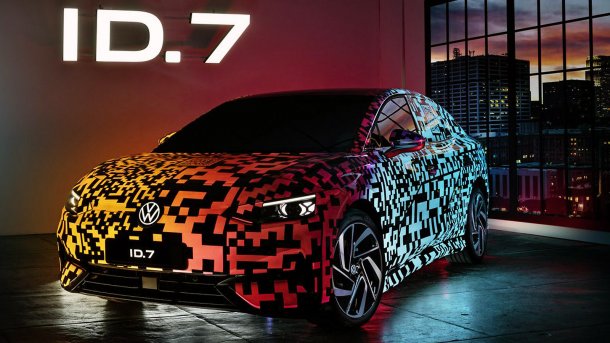Presentation VW ID.7: Electric car in the luxury class
VW wants to compete in the upper class of e-limousines around five meters long with the ID.7 from summer 2023. The first details are available at CES.

With the ID.7, VW wants to reach affluent buyers who have no use for the SUV trend.
(Bild: VW)
(Hier finden Sie die deutsche Version des Beitrags)
It has been a few years since VW had a sedan above the Passat in its lineup. The VW Phaeton was underestimated at the time of its production, and sales figures fell short of expectations. With the battery-electric VW ID.7, Volkswagen is making a new attempt in the direction of the luxury class. It is also becoming clear how the modular electric construction kit will continue. VW shows a camouflaged prototype at the CES in Las Vegas.
At just under five meters in length, the VW ID.7 towers over the Passat by just under 20 cm. This makes it similar in length to a Mercedes EQE and the upcoming BMW i5. The wheelbase of the ID.7 measures 2.97 m, which suggests plenty of interior space. Wind-cheating shapes stand out under the camouflage film, although Volkswagen does not yet reveal the cW value.
Progress in charging power and battery
VW is also still keeping other technical data secret. On the further developed basis of the Modular Electric Building Kit, internally called MEB+, significant progress should be visible in terms of energy content and charging performance. So far, however, there are only a few vague key data: The range is supposed to be up to 700 km, made possible by excellent aerodynamics and an enlarged battery. So far, the MEB has peaked at 77 kWh. If the 700 km in the cycle is halfway realistic, the battery will have an energy content of rather more than 100 kWh.
(Bild: VW)
VW ID.7: Is NMC811 coming?
The material mix of the battery cells in the VW ID.7 is still a secret. So far, NMC622 has been used in the MEB, i.e. six parts nickel and two parts each manganese and cobalt. It is possible that VW will reduce the proportion of manganese and cobalt, as has already happened in many cases with the competition, so that a mixture ratio of NMC811 could result.
VW also promises progress in terms of charging speed, with talk of "more than 200 kW". In the MEB, up to 170 kW has been possible in isolated cases. However, it's not so much the peak power that's exciting for the advertising, but rather the conditions under which it can be used and for how long. Because that ultimately determines how long the charging pause will be in practice. Since this is a further development and not a new platform, the voltage level will remain at 400 volts.
(Bild: VW)
Interior noble
The ID.7 should have nothing in common with the harsh galley charm of the previous MEB models. Otherwise, the claim of seriously wanting to play in the upper segment would hardly be credible to sell. So we can expect VW to return to a certain superficially high-quality impression. Strikingly, the brand has also responded to criticism in a few other places. The sliders remain, but are now finally illuminated. Instead of the cheap-looking, free-standing mini-screen that houses the instrument cluster, this is now recessed again in the ID.7. Operation has been further simplified, VW promises. It can also be expected that VW will further improve the software before the launch. An ID.Buzz, which my colleague Christoph had in the test, gave hope in this regard. The infotainment system is still not particularly fast, but at least it ran stably.
VW has retained the idiosyncratic cost-cutting idea of no longer placing separate buttons for the rear window regulators in the driver's door. If you want to open or close the rear windows, you have to switch the buttons at the front. The automatic climate control in the ID.7 is supposed to be truly innovative. When the driver approaches the car, it already starts air conditioning the interior, depending on the outside temperature. The system is supposed to reach the target temperature particularly quickly because the air vents can move automatically and thus distribute the air flow in different directions.
(Bild: VW)
From the summer at the retailers
The ID.7 is scheduled to hit the market in China, Europe and the U.S. starting in the middle of this year. VW will presumably not name prices until later this spring, and a bargain is not to be expected. The large battery alone will reliably prevent that. Where it could go financially is shown by the competition. A Mercedes EQE 300 is currently available from 66,402 euros. The VW ID.7 with a slightly larger battery will presumably not cost much less.
(mfz)